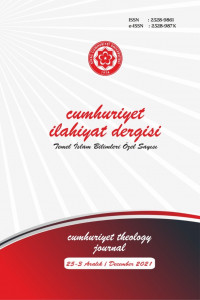Zeydî Fukahânın Tasnifi: Bülûġu’l-ereb ve künûzü’ẕ-ẕeheb fî-maʿrifeti’l-meẕheb Adlı Eser Çerçevesinde Bir İnceleme
The Classification of Zaydῑ Fuqahāʾ: A Study within The Framework of The Work Named Bulūgh al-arab wa-kunūz al-dhahab fī maʿrifat al-madhhab
Author(s): Eren GündüzSubject(s): Theology and Religion, Islam studies, Philosophy of Religion, Philosophy of Law, Sharia Law
Published by: Cumhuriyet Üniversitesi İlahyat Fakültesi
Keywords: Islamic Law; Zaydī; Ṭabaqāt al-fuqahāʾ; Bulūgh al-arab; al-Muḥaṣṣilūn; alMudhākirūn;
Summary/Abstract: In this study, the classification of Zaydī fuqahā’ that emerged in the mutaaḫḫirūn period of Zaydī fiqh and related terms are examined. The book named Bulūgh al-arab wakunūz al-dhahab fī-maʿrifat al-madhhab, which has great importance among the studies aiming to present the Zaydī fiqh accumulation as a uniform doctrinal structure was taken as a basis in the processing of the subject. After an introduction in which Zaydī fiqh studies are evaluated in their relationship with the subject, the issue is addressed under three main headings. In the first title, the author and his work are introduced, and in the second and third titles, the methods and terms used in the classification of the Zaydī fukahâ are examined. The author of the work is ʿAlī b. ʿAbd Allāh al-Shaharī (d. 1190/1776) who lived during the period of the Qāsimī dynasty (al-dawla al-Qāsimiyya) in Yemen. The most important characteristic of this work, which was prepared by using many important sources in the Zaydī literature, is that it was the most comprehensive study written on madhhab doctrine until then. The first part of the work explains that the right madhhab to be followed is Zaydiyya. In the second part, the classes of the Zaydī fuqahā’, which is the subject of our study, are explained. The fuqahā’ classes are primarily divided into two parts: al-salaf al-ṣāliḥīn and al-ḫalaf al-ṣāliḥīn. The first dates back to the beginning of the 3rd/10th century. This class is divided into two parts, as al-sābiqūn and al-mutaaḫḫirūn. The sābiqūn starts with ʿAlī b. Abī Ṭālib and his two sons al-Ḥasan, and Ḥusayn, and ends with the sons of twelve imams who are their descendants. Zayd b. ʿAlī (d. 122/740) is one of the twelve imams. The most important of the faqīhs in the part of mutaaḫḫirūn, which started with al-Qāsim b. Ibrāhīm al-Rassī (d. 246/860), are the six imams called ahl-al-nuṣūṣ or aʾimma al-nuṣūṣ. The reason why they are named as such is that their words were taken as a basis in determining the views of the sect on the field of uṣūl and furūʿ l-fiqh. al-Qāsim al-Rassī is at a point where all the knowledge of the Prophet's family and the principles agreed upon by sābiqūn, reach him through many channels. al-Hādī Yaḥyā b. al-Ḥusayn (d. 298/911), grandson of al-Qāsim, is the most important imam in terms of his position in the madhhab. The ḫalaf al-ṣāliḥīn is also divided into two parts as ahl l-taḥṣīl and ahl l-naẓar. The first part also referred to as muḥaṣṣilūn or aʾimma al-taḥṣīl, has no subcategories. The second part is divided into two sub-sections as ahl l-taqrīr and mudhākirūn. The muḥaṣṣilūn class starts with those who catch up with the last class of ahl al-nuṣūṣ and ends with ʿAbd Allāh b. Ḥamza (d. 614/1217), one of the three important imams. Two other important imams of muḥaṣṣilūn are Aḥmad b. al-Huṣayn (d. 411/1020) and his brother Yahyā b. al-Husayn (d. 424/1032). It is the fiqh activity of the jurists of this class, called taḥṣīl lmadhhab, that brought Zaydī fiqh, which was fiqh of imams (madhāhib l-aʾimma) in its first period, into a single madhhab and to its classical form in the last period. Mudhākirūn jurists lived at the same time as the ahl-t-taqrīr. This period is about 700 years from the beginning of the 6th/12th century, which is the last century of the muḥaṣṣilūn class, to the end of the 12th/18th century, when Shaharī lived. The roles of the ahl al-taqrīr in the madhhab mostly consist of reviewing the works of the ahl-l tahṣīl, approving the correct ones, and correcting the wrong ones. That's why they are so named. The author of Kitāb l-Azhār, Aḥmad b. Yaḥyā l-Murtaḍā (d. 840/1437), is one of the prominent jurists among the ahl l-taqrīr. The majority of Zaydi fuqahā’ belongs to the muẕākirūn class. These are the lowest class of the ahl-al-naẓar. As an important result reached in the study, it is possible to state the following: There is a difference between some of the knowledge and opinions in modern Zaydī studies, which include the same subject as Shaharī's work, in terms of the classification of Zaydī fuqahā’ and the terms used. Therefore, the findings and conclusions based on this work should be confirmed by new studies on other Zaydī classics, and existing opinions on Zaydī jurisprudence should be reviewed.
Journal: Cumhuriyet İlahiyat Dergisi
- Issue Year: 25/2021
- Issue No: 3
- Page Range: 1485-1505
- Page Count: 21
- Language: Turkish

